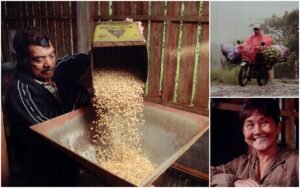
KERA takes the lead in making Kidapawan an important center for coffee.
Say “Philippine coffee” and what comes to mind is the barako (Liberica) variety grown in Batangas. But while Luzon may have been the major producer of coffee in years past, there has been a silent southern shift in the last decade or so. Today, it is Mindanao that produces most of the coffee in the Philippines, accounting for as much as 75% of the total volume.
Region 12 is the biggest coffee producer in Mindanao, and in this area, Kidapawan City is fast becoming a mecca for coffee industry players. Production had been dwindling up to a few years ago, but a coffee project awarded by the Department of Agriculture (DA) to the Rural Improvement Club (RIC) Producers Cooperative in 2013 became the catalyst for its resurgence.
“Kasilak was able to access the coffee roasting facility worth P817,100.00 from the Department of Agriculture that gave us a complete set of coffee production equipment,” Sheila Leong, the cooperative’s coffee processor, says. The equipment package was composed of a depulper, dehuller, all-weather drier, moisture tester, roasting machine, grinder, and packager—- all given free of charge.
“What the DA gave allowed us to process coffee through all its stages,” says cooperative manager Annania Sarigumba. “Coffee na ang labas (The end product is roasted coffee).”
At the time, RIC was in the garment business and was using a large building right in the heart of Kidapawan City for its operations provided by the City Government of Kidapawan. “We had a big place and some areas were not being used,” Sheila says. “We renovated a part of it and turned it into a coffee shop where the coffee roasting equipment was also located.” The cooperative decided to call its coffee business KERA — Kidapawan Excelsa, Robusta, Arabica — after the three varieties they had initially thought grew in Kidapawan. “It was too late when we found out we were wrong,” Sheila says. “We had already registered the name when we discovered that we also have Liberica here.”
The estimated cost for the entire project – including the building renovation as well as training sessions for Shiela – rang in at P1.6 million with support coming from Dole-Stanfilco, the Department of Agriculture (DA), CRS Philippines under its USDA funded FARM Project, and the City Government of Kidapawan. As it turned out, the money and effort were well worth it. “The coffee industry in Kidapawan was revived by this project because KERA would buy from the farmers at a higher rate than the local market,” Sheila proudly says.
KERA buys a minimum of 60 kilos of green coffee beans a month, increasing it to as much as 200 kilos during peak season. The cooperative earns almost in gross sales a year from both its coffee shop and roasted coffee businesses. Needless to say, it also gives coffee farmers a huge boost in their income.
KERA’s goal is to be a major supplier of coffee — both roasted and unroasted — by the end of 2017.“l’m continuing to study more so that we can supply high-quality coffee,” Sheila says. “We also constantly innovate so that we can tap new markets!” Kasilak, for its part, continues to help KERA in the production, marketing, and logistics side of the business.
Annania and Sheila know it will take a lot of hard work to achieve their goals, but they are prepared to do whatever it takes. After all, nothing is instant when it comes to coffee success.



